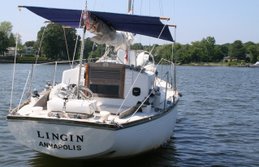Crew: Glen, Brian P., Nick, Xa, Chuck O'Malley and Tim
Competitors: 550, 247, 484
It was a momentus night in many ways tonight:
- It was Nick's first race (Nick works with Glen and came out for a Canadian Race last season, but it was cancelled due to too much wind.)
- It was our first race of 2006.
- It was the first time we had Chuck O'Malley of Doyle Sailmakers on board coaching us. (Chuck has made a jib and spinnaker for us.)
- It was our first race with THE ROCKET.
We had a tight start, with Harry barging like a crazy man (along with a bunch of boats in other classes). Nick had asked before the race if there were many collisions in these big boats. We said, "no". We came very close to having to eat our words. We, however, squeaked by and ended up right at the boat on the line with enough speed. We started in first and never looked back.
The upwind leg was a straight shot, and on the reach to the next mark, we made out well with the Cals. Chuck had us keep high to force a PHRF class that started late from rolling us.
At that mark we had to give a Cal room. This lead to an excellent discussion about Rule 18: ROUNDING AND PASSING MARKS AND OBSTRUCTIONS on the way home, repleat with great use of the model boats that my son, David, and I built over the winter. BTW: I highly recommend you check out the rules. They're free to download and are found at http://www.ussailing.org/rules/.
The next leg, we made a couple of tacks, then set the spinnaker...I mean THE ROCKET. It was a sight to behold! It looks awesome!
Xa did great job taking us downwind, and we even did a windward douse per Chuck's direction. The crew was pretty enthusiastic, but I really need to get Xa's thoughts on it. It's nice because the chute goes straight into the forward hatch and therefore there are fewer people back in the cockpit area causing trouble.
Tacking into the harbor as the wind lightened up, we maintained our lead and watched as Towney and T.C. dueled it out behind us. Unfortunately, though we got 1st, the gun wasn't functioning so we only got the horn. That's okay because we started the season with a BANG!
A couple thoughts from our coaching with Chuck. (Crew--please leave comments!!!)
- Glen is going to be focused on strategy this year. I really liked Chuck's steady stream of guidance in short clear terms. It was really helpful.
- Backstay tension is important especially in heavy air. Chuck saw headstay sag during our upwind sailing, which leads to overpowering and poor pointing.
- Bring the traveller up in lighter air, down in heavier air.
- Tighten the main shrouds 2 turns to help tighten the rig.
- Consider the windward chute take down.
- There's more I know I'm forgetting...
--Tim


2 comments:
Crew--
We had some discussion on board last night about why Chuck said to bring the traveller to windward in light air. J Bergquist, a regular LinGin blog reader :-) , had this great explanation as to the reason. (Note: CL = Center Line) Makes good sense to me.
--Tim
Traveler up in light, down in breeze. This is one I know, but you didn’t explain in your post WHY you should do that. The reason (I think) is because in light air you want to keep the same leech profile, which means you need less leech tension for the same sheeting angle. If you leave the traveler on CL, then you have to sheet really hard to get the boom to CL, which closes your leech too much and screws up your leech profile….too much tension. By moving the traveler up to windward, you can use much less sheet tension to get the boom to CL, which allows for a good sheeting ANGLE while still allowing for a good sail shape (leech profile). You get the boom on CL without closing the leech down.
Just to add an addendum to this...
Using the traveler and mainsheet together to control both leech profile and sheeting angle is kind of like vang sheeting in a boat without a traveler. In that case you use the vang to control leech tension and sheet for sheeting angle. Since 505's don't have a traveler, but only a split-bridle mainsheet with a very powerful (24:1) vang, they work this way.
This is normal on American boats...european ones often have mid-boom sheeting and either a hoop or a traveler. So they sheet more like an Alberg.
Then on a laser, for example, you use vang to induce mast bend to flatten your main. When it's really breezy, you just whale on the vang, but not for the purpose of closing the leech but for driving the boom forward into the mast, pushing the lower mast forward, thus flattening the main.
Post a Comment